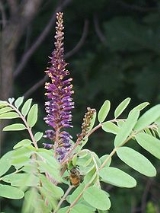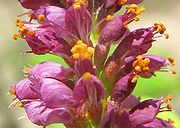
Amorpha fruticosa
Encyclopedia
Amorpha fruticosa is a species of flowering plant in the legume family
known by several common names, including desert false indigo and bastard indigobush. It is found throughout eastern Canada, northern Mexico, and most of the continental United States, but it is probably naturalized
in western areas. It is also present as an introduced species in Europe, Asia, and other continents. It is often cultivated as an ornamental plant
and some wild populations may be descended from garden escapees.
 A. fruticosa grows as a glandular, thornless shrub
A. fruticosa grows as a glandular, thornless shrub
which can reach 5 or 6 meters in height and spread to twice that in width. It is somewhat variable in morphology. The leaves are made up of many hairy, oval-shaped, spine-tipped leaflet
s. The inflorescence
is a spike-shaped raceme
of many flowers, each with a single purple petal and ten protruding stamen
s with yellow anthers. The fruit is a legume pod containing one or two seeds.
6'-O-β-D-glucopyranosyl-12a-hydroxydalpanol, a rotenoid
, can be found in the fruits of A. fruticosa.
Fabaceae
The Fabaceae or Leguminosae, commonly known as the legume, pea, or bean family, is a large and economically important family of flowering plants. The group is the third largest land plant family, behind only the Orchidaceae and Asteraceae, with 730 genera and over 19,400 species...
known by several common names, including desert false indigo and bastard indigobush. It is found throughout eastern Canada, northern Mexico, and most of the continental United States, but it is probably naturalized
Introduced species
An introduced species — or neozoon, alien, exotic, non-indigenous, or non-native species, or simply an introduction, is a species living outside its indigenous or native distributional range, and has arrived in an ecosystem or plant community by human activity, either deliberate or accidental...
in western areas. It is also present as an introduced species in Europe, Asia, and other continents. It is often cultivated as an ornamental plant
Ornamental plant
Ornamental plants are plants that are grown for decorative purposes in gardens and landscape design projects, as house plants, for cut flowers and specimen display...
and some wild populations may be descended from garden escapees.

Shrub
A shrub or bush is distinguished from a tree by its multiple stems and shorter height, usually under 5–6 m tall. A large number of plants may become either shrubs or trees, depending on the growing conditions they experience...
which can reach 5 or 6 meters in height and spread to twice that in width. It is somewhat variable in morphology. The leaves are made up of many hairy, oval-shaped, spine-tipped leaflet
Leaflet
A leaflet in botany is a part of a compound leaf. A leaflet may resemble an entire leaf, but it is not borne on a stem as a leaf is, but rather on a vein of the whole leaf. Compound leaves are common in many plant families...
s. The inflorescence
Inflorescence
An inflorescence is a group or cluster of flowers arranged on a stem that is composed of a main branch or a complicated arrangement of branches. Strictly, it is the part of the shoot of seed plants where flowers are formed and which is accordingly modified...
is a spike-shaped raceme
Raceme
A raceme is a type of inflorescence that is unbranched and indeterminate and bears pedicellate flowers — flowers having short floral stalks called pedicels — along the axis. In botany, axis means a shoot, in this case one bearing the flowers. In a raceme, the oldest flowers are borne...
of many flowers, each with a single purple petal and ten protruding stamen
Stamen
The stamen is the pollen producing reproductive organ of a flower...
s with yellow anthers. The fruit is a legume pod containing one or two seeds.
6'-O-β-D-glucopyranosyl-12a-hydroxydalpanol, a rotenoid
Rotenoid
Rotenoids are naturally occurring substances containing a cis-fused tetrahydrochromeno[3,4-b]chromene nucleus. Rotenoids are related to the isoflavones....
, can be found in the fruits of A. fruticosa.
Cultivars
- 'Albiflora', with white flowers.
- 'Crispa', with curled leaves.
- 'Lewisii', with narrow leaves.
- 'Pendula'Amorpha fruticosa 'Pendula'Amorpha fruticosa 'Pendula, or Weeping Desert False Indigo, is a weeping shrub and a cultivar of Amorpha fruticosa, the Desert False Indigo. It was first described in 1868 by Élie-Abel Carrière from France. No trees are known to survive of this cultivar...
, with arching branches, forming an dome shape.

